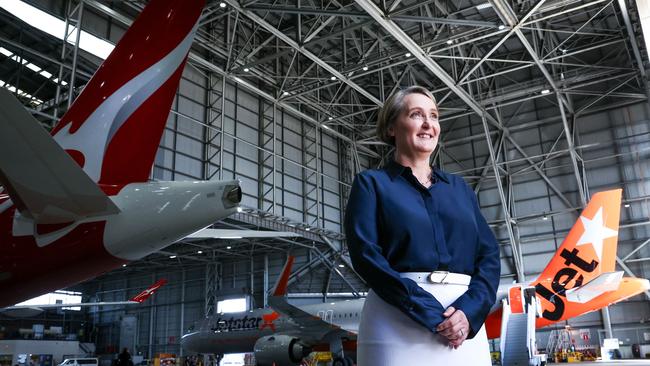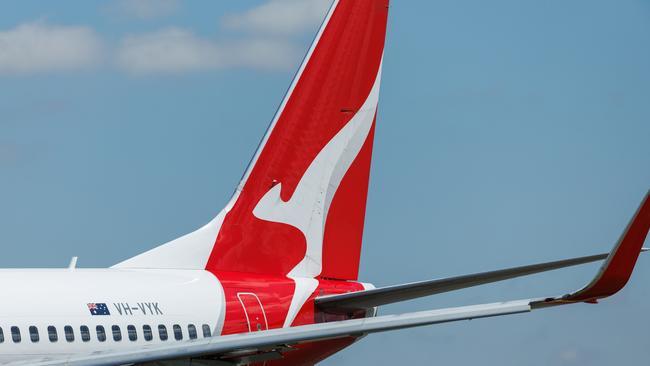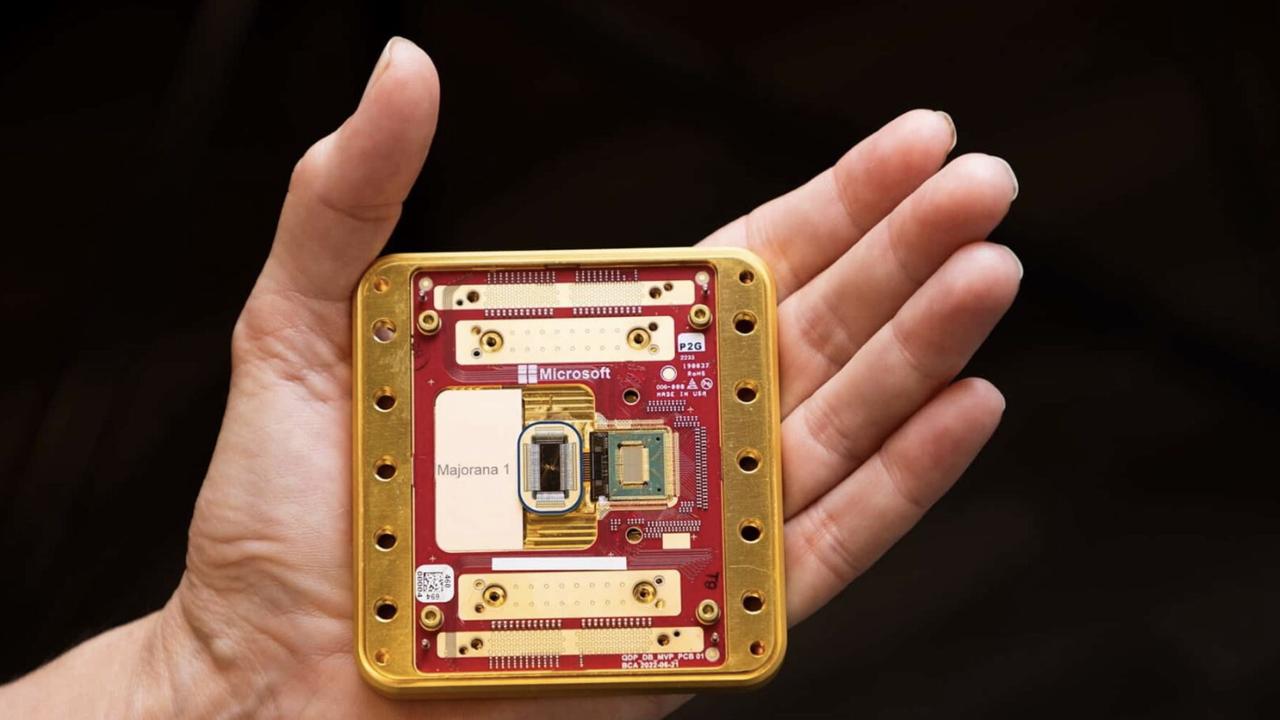Earn vs. burn: Why Qantas needed to revamp its frequent flyer
There is more at stake than winning over customers, Qantas’ frequent flyer scheme represents a business too big to ignore.

Business
Don't miss out on the headlines from Business. Followed categories will be added to My News.
Qantas boss Vanessa Hudson knows that one of the fastest ways to win over her customers is through the upping the perceived value of the airline’s monster frequent flyer program.
Until now, the question has largely been how much has she been willing to pay to do this.
The new Qantas boss is continuing with her customer charm offensive, signalling she will spend as much as $120m in the coming year and beyond as part of the biggest shake-up of Qantas Frequent Flyer program in more than three decades. Much of this will be on releasing 20 million frequent flyer seats, so members now have a much better chance at redeeming them.
Loyalty has been one of Qantas’ biggest cash cows, just as much as a customer pain point. It is said that most people check their frequent flyer points balance more than their super balance.
The program is Australia’s largest with more than 16 million members, giving the airline an emotional connection to nearly every adult.
It generates hundreds of millions of dollars annually by selling points from banks for credit cards and loans, retailers like Woolworths, hotels and hundreds of other business partners.
The scheme famously kept the airline afloat during the Covid-19 groundings and last year loyalty made more money for the airline than Qantas’ Jetstar franchise.
On a revenue measure, loyalty for Qantas is far more profitable than flying customers from one destination to the next, generating profit margins of a hefty 21 per cent. (Qantas’ most profitable operational division – domestic – generates margins of 17 per cent, international generates less than 8 per cent).

This coming year, loyalty is set to make more than $500m for Qantas and Hudson is targeting double-digit growth rates right through to the end of the decade, where the airline is hoping to hit $1bn in annual earnings.
However, the story of Qantas over the past decade under former boss Alan Joyce has been about delivering for investors, with customers coming second. Since the intense backlash against the former boss and the Qantas board last year, Hudson has a mandate from her new board to shift the balance.
For years, the airline became too focused on the “earning” part of the program, and the five million seats on offer under the current scheme were nowhere near enough for members to “burn”. It faced constant criticism that members weren’t able to book seats, and those that finally secured one were on a plane that went nowhere.
The shake-up will see the introduction of a new way to redeem points through Classic Plus, releasing four times the amount of seats over the Classic points program, which offers 5 million seats. While the Classic program remains selling seats at a fixed price, the new Classic Plus sells points seats at market rates – including spot sales.
Hudson tells The Australian the changes offer more options for customers to “burn” points. “We have been investing in both the earn and burn for members, but increasingly what we have seen and what we have been hearing from members is a desire to be able to use their points to travel and travel to the destination that they want”.
She says the changes are about making sure the airline evolves with its customers.
“At the heart of the loyalty program is having engaged members,” Hudson tells The Australian.
Having more engaged members is also very good for the frequent flyer business. Someone is more likely to take out a credit card or a health insurance if there’s a perception they have a better chance of eventually redeeming a flight – even if they never do. This is the secret to selling more points to partners and being able to attract new partners over time. And this is the key to Qantas’ hitting its aspirational target of $1bn in annual earnings by the end of the decade. Despite the higher cost of the program outlined by Hudson, the potential for earnings upside is why Qantas shares jumped almost 5 per cent on Monday, its biggest jump in more than a year.
Retailers like Myer have shown the strength of their loyalty program in helping to drive sales even through broader economic downturns. Myer has also used analytics to dish out perks or savings, that ultimately had millions of members spending more and coming back frequently. It’s little wonder Myer sees its future in loyalty by punting on the appointment of former Qantas frequent flyer boss Olivia Wirth as its new chief executive.
Hudson says the changes have been a long time coming and were worked on as part of the airline’s post Covid-19 recovery. While she initially flagged the changes as last year’s annual meeting, she dismissed the suggestion the change have been made in response to last year’s customer revolt. The loyalty changes mark Hudson’s second big pro-customer move in as many months.
In February, she shifted her interim earnings briefing to a hanger at Sydney airport to show the arrival of the new, more comfortable Airbus A220s.
Loyalty represents the single biggest lever to bring higher-value customers back. Now it is up to Hudson to keep them there.
Thorburn follows Baird
There was some symmetry in former National Australia Bank chief Andrew Thorburn being named as the next CEO of not-for-profit aged care provider HammondCare, taking over from Mike Baird in June.
Remember, it was Thorburn who appointed Baird in his first job after leaving the post of NSW Premier. Baird was named NAB’s institutional banking boss in early 2017 and the two have remained close even after Thorburn’s troubled exit from NAB several years ago.
Thorburn has been keeping a very low profile in Melbourne since his bruising episode with the Essendon football club 18 months ago. He resigned after 24 hours after being named Essendon CEO when an ultimatum was issued to choose between the club or the church he also chaired that had expressed homophobic views. After an intense public backlash, Thorburn later pulled back from all board roles, including the City on a Hill church and Sydney-based impact investor Sentient he also chaired.

By taking charge of aged and dementia care specialist HammondCare, the 58-year-old Thorburn has taken a big step in reviving his executive career. As Baird found, the not for profit doesn’t come with daily public scrutiny, but he was able to use his profile to draw attention to the challenges of the industry. Significantly, the position delivers a community benefit, something Thorburn has been looking to pursue since he left his career in banking behind.
For Thorburn, the role also represents the Royal Commission rebuild he never had a chance to do. His position at NAB was famously cut short when Commissioner Kenneth Hayne questioned whether Thorburn and his then NAB chairman Ken Henry understood the gravity of what was needed to change the culture and break the habits of the past. Leading up to his resignation, Thorburn said he was determined to lead NAB through the rebuild.
HammondCare is backed by an independent Christian charity and the entire sector is part of the way through sweeping reforms to boost accountability and transparency that stem from the aged care Royal Commission, where the final report was released in three years ago.
Thorburn said: “A focus on people has been central to every role I have held and, together with the team, I will build on that as we serve residents, clients and patients.”
He also believes the aged care sector could benefit from “new funding sources, greater employment of technology and continued innovation to resolve workforce shortages”.
This is significant. Through his tenure at NAB he spent a lot of time on streamlining the bank, including pulling it back to the core. He directed a major digital upgrade of NAB – and the benefits of this investment are flowing through the bank today.
Baird has previously flagged his intention to step down from HammondCare as he moves into the role of chair of Cricket Australia. At the same time Baird will also step down as chair of the ASX-listed Future Generations Global fund, although he will remain on the board. Former RBA governor Philip Lowe was last month appointed chair of the Future Generations fund.
johnstone@theaustralian.com.au
More Coverage
Originally published as Earn vs. burn: Why Qantas needed to revamp its frequent flyer





